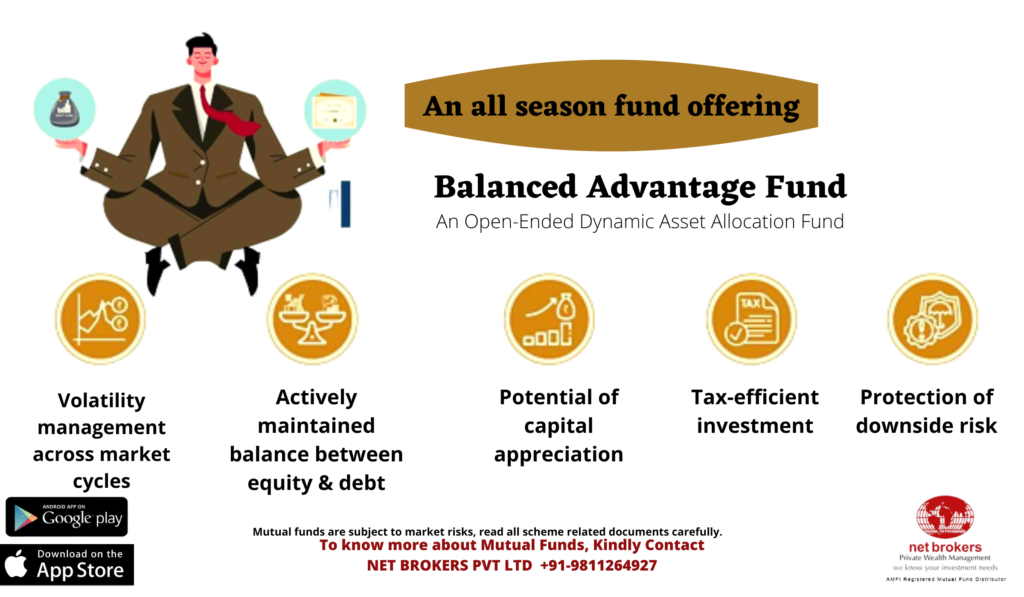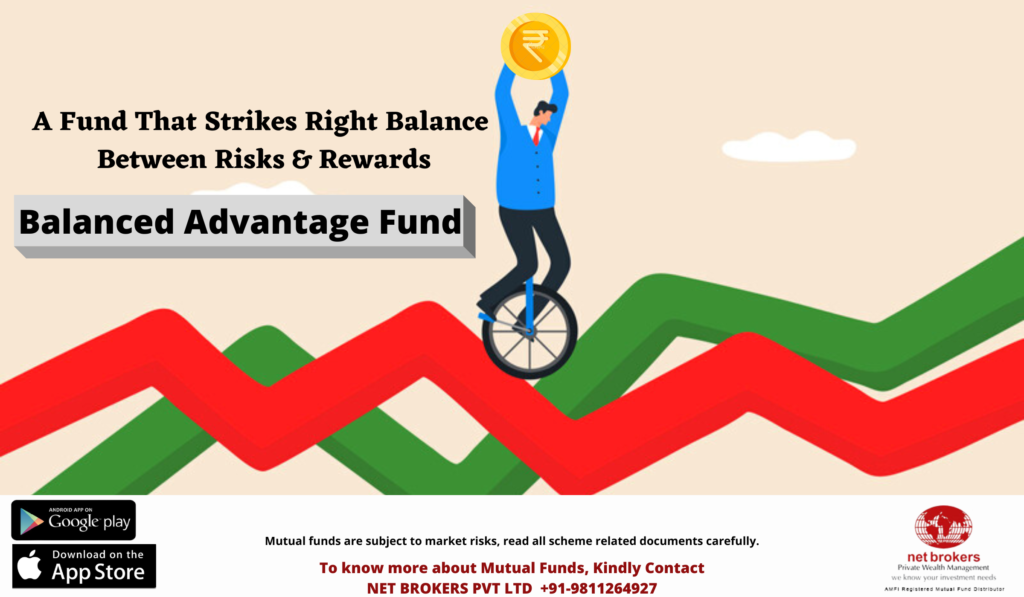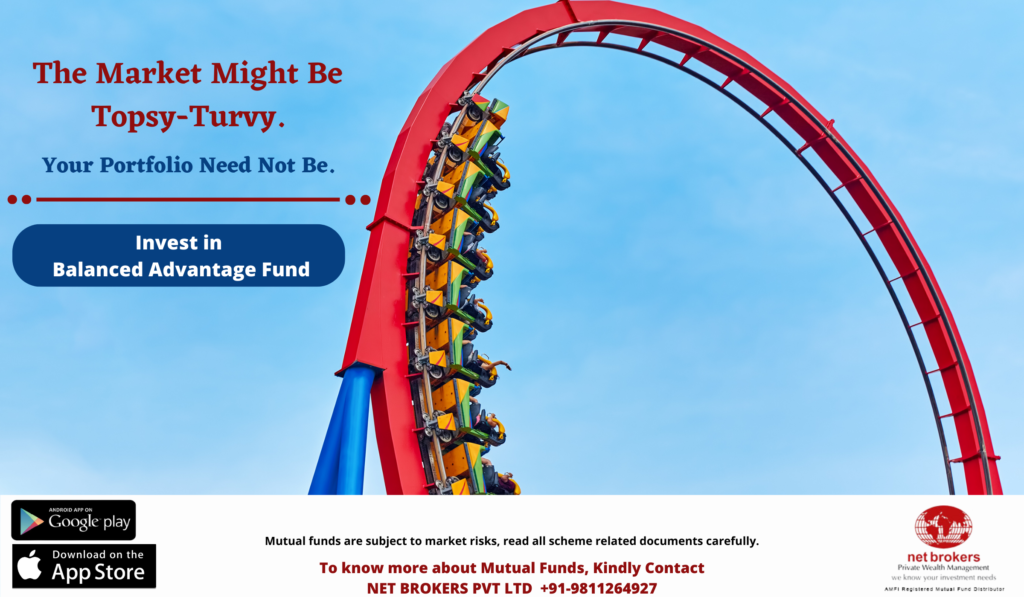Understanding Balanced Advantage Funds
By Akhil Chugh
Date July 24, 2022
Volatility is the essence of the market. There are many factors that trigger volatility such as RBI policy, government policy reforms, global macroeconomic developments, geopolitical events, etc. The sooner investors accept volatility as a friend and learn to manage it, the better off your investment will be. It is not possible to control the macro-economic variables impacting volatility but we can take actions to reduce their impact on the investment portfolio. Investing in Balanced Advantage Funds is one such investment strategy to beat the impact of volatility on your portfolio.
To understand the significance of investing in balanced advantage funds, let’s understand Balanced Advantage Fund (BAF) in detail.
What are Balanced Advantage Funds?
Balanced Advantage Funds are a type of hybrid mutual fund investing in more than one asset class (e.g., equity, fixed income securities, etc). Balanced Advantage Funds are also called Dynamic Asset Allocation Funds as BAFs manage their exposure to equity, arbitrage & debt instruments based on a pre-defined investment model where exposure to different asset classes is defined based on market valuation parameters like price to earnings ratios, price to book value, etc. Equity Allocation ranges from 20% – to 80% based on market valuations. The category was created based on new norms from the Securities and Exchange Board of India (SEBI) and is free of any minimum exposure limits or caps from the same.

While equity investments provide market-linked returns, debt instruments offer fixed returns. Since the fund has the flexibility to shift allocation between the asset classes based on a pre-defined investment model depending on market valuations, when the markets are expensive, the fund moves to debt instruments and vice versa.
The dynamic nature of these funds is attributable to pre-defined in-house models based on which the fund house makes allocations across different instruments. Furthermore, these funds maintain market exposure to equity derivatives to leverage equity tax treatment and hedging when stocks are overvalued.
Features of Balanced Advantage Funds:
Markets are volatile and Balanced Advantage Funds (BAFs) use this volatility as their growth tool through an effective strategy. Equity offers market-linked returns and debt offers a regular income. In the long term, investors must be willing to take risks to earn from equities while aiming at fixed income. Dynamic asset allocation funds are a good choice for effective wealth creation planning. Some of its key features are:
1. Hybrid Fund
Balanced Advantage Funds are types of Hybrid funds investing in a mix of equities, debt and arbitrage opportunities. The equity component helps to create wealth in the long run while the debt component provides safety during the market downturn giving steady returns. Equity and fixed income exposures in Balanced Advantage Funds are usually decided by the asset allocation model of the funds under a prevailing market condition.

Balanced Advantage Funds usually manage an equity allocation between 20% and 80% as per the market valuations. In doing so, Balanced Advantage Funds invest predominantly in stocks and other equity-related instruments to gain appreciation in the equity market.
Usually, the debt component is capped at 35% to ensure the taxation is as per the norms of equity funds. However, the debt exposure may be increased if markets are expected to crash.
The arbitrage component is the completely hedged equities that are not exposed to market risks. Depending upon the investment model of each fund, the fund can tactically take duration and credit calls to benefit from higher interest coupons and price fluctuations, which further contribute to the fund’s performance.
2. Dynamic Allocation – To Beat Volatility

Most hybrid funds have to follow a static asset allocation rule as mandated by SEBI. Hence, they have a limitation on adding equity or debt components to the portfolio. However, Balanced Advantage Fund is a dynamic asset allocation fund that can dynamically change the asset class investment as per the market valuations. This helps in tapping the high returns of the markets along with the security of debt instruments. It has unique in-built re-allocation tactics to give risk-adjusted returns. It also saves you from timing the market to make investments in these funds because they rebalance the assets as per the market conditions to make the most out of the market cycle.
3. Diversified Portfolio
Within equity asset allocation, Balanced Advantage Funds spread the investment over large-cap and mid-cap stocks. They ensure the stability of large companies and benefit from the growth potential of medium-sized companies simultaneously. This saves from the concentration risks of the equity markets and helps offer investors a risk-adjusted return.
4. Taxation
Not only do Balanced Advantage Funds make your asset allocation automatic, they also do it in a more tax-effective manner than what investors can do at an individual level. When investors manually move their money between equity and debt, they could be subjected to taxes on the capital gains made in the short term.
However, Balanced Advantage Funds are structured in a manner where the fund moves between two asset classes as a part of their routine rebalancing. It is not liable for taxes. Only when an investor is selling the final sales proceeds are taxable in the hands of the investors.
Furthermore, even after the rebalancing, the tax treatment of the fund continues to remain equity-oriented, which is ultimately beneficial for investors, as equity funds pay a lower tax rate than debt-oriented funds.
5. No exit load:
There are no exit loads for shifting from one asset class to another within the scheme. There are several options available to the investor when it comes to investing in these funds.
Key Takeaways from Net Brokers:
- Balanced Advantage Funds are known as– the “all-season” funds. However, while they remain unharmed by market volatility, you should only invest in BAFs if you are ready to stay invested for a long investment horizon.
- If you are a new investor unwilling to withstand present-day market volatility, Balanced Advantage Funds are ideal for you. These asset allocation funds can serve as risk-adjusted solutions.
- Balanced Advantage Funds are also the best category of mutual funds for passive investors who often do not want to rebalance their funds.
- In current times of volatile markets, investors can opt for lumpsum investment in Balanced Advantage Funds to earn good returns in the long run.
- Invest in Balanced Advantage Fund with an investment horizon of at least 5 years to earn the desired returns from your mutual fund investments.
Given the existing volatility of the market, Balanced Advantage Funds (BAFs) are one of the best investment solutions for dynamically navigating the equity market and reducing the impact of any market volatility to ensure investors a smooth ride with handsome returns.
Consult Net Brokers team if you need any help in knowing the risk characteristics of a scheme or your risk profile. You should always make informed investment decisions based on your risk appetite and investment needs.
For more information, get in touch with us today!
Download our mutual fund app & start investing in different mutual fund schemes to attain your long-term financial goals.
Happy investing!



